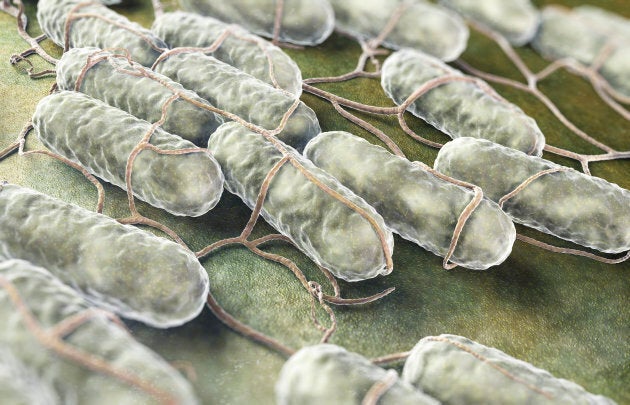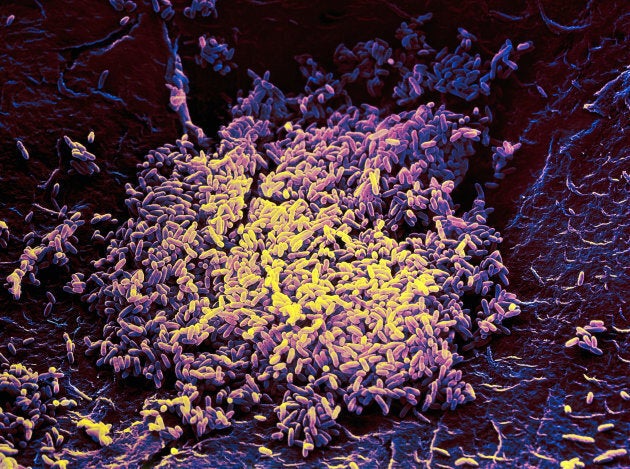It seems not a day goes by without some report of a foodborne outbreak or recall. In the last month alone, there have been 30 recall notices from the Canadian Food Inspection Agency, many of which highlight microbial contamination. The problem is so common the government has a Food Illness Outbreak Response Protocol in place to deal with the continual threat.

Several different bacteria and viruses have the potential to contaminate food, yet two species seem to dominate the headlines these days. They are listeria and salmonella. For decades, these two species have been the root of many outbreaks in Canada leading to numerous illnesses and deaths. Yet, how exactly these two culprits manage to get past the manufacturing process — which includes pathogen-killing steps — has been a mystery.
Now, a team of British researchers may have solved this microbiological riddle. They have discovered the two bacterial species possess an ingenious method to stick around on foods after decontamination and to avoid detection. The results may force public health officials to re-think the current methods for surveillance to ensure a safer food supply.
The team wanted to know whether these species were taking on a different type of living during the manufacturing process, specifically the decontamination step. It's known as the Viable-But-Nonculturable — or VBNC — state. As the name implies, the bacteria are alive, but they do not grow to high enough numbers to form colonies on a petri plate. Certain bacteria adopt this state when the environment is threatening and they need to protect themselves instead of forming large communities. If these two bacteria types were capable of using this phenomenon, it could answer the question regarding how outbreaks could occur even with proper processing.

The researchers focused on a common source for the bacterial species, spinach. It's one of the more hardy leafy greens and known to be involved in outbreaks. About 50 million bacteria were added to the leaves and allowed to incubate for a day. Then the samples were sent through a decontamination step similar to those done in processing plants. The leaves were washed with a chlorine solution — similar to diluted bleach — for two minutes, a time usually long enough to kill most bacteria, and then analyzed the results. If any bacteria survived, the group determined if they were in their normal or VBNC state.
Not surprisingly, the team found VBNC bacteria after the washing step. But rather than a fraction of the surviving bacteria choosing this state, the group realized all of the bacteria switched within two minutes of exposure to levels of chlorine normally used in food processing. The team confirmed this by attempting to grow the bacteria on petri plates. As expected, no colonies formed. The bacteria had evaded the standard method for surveillance.
The discovery was troubling enough but the team wanted to make sure the VBNC bacteria could still cause infection. After all, even if bacteria survive the washing process, unless they can cause illness, the food still could be considered safe.
More blogs from Jason Tetro:
The experiment was done using a well-known model for determining bacterial pathogenicity. It's a microscopic worm known as Caenorhabditis elegans, although most people just call it C. elegans. It has a hunger for bacteria and finds both Salmonella and Listeria tasty.
The VBNC bacteria were fed to the worms, who were then observed for any sign of infection. If the bacteria were still pathogenic, the worms would die quickly. They did. Some or all of the bacteria maintained their ability to cause infection.
As to how many bacteria were capable of causing infection, the team performed a comparable experiment using petri-plate-grown bacteria. There were no differences in the worms' lifespans. The team showed both normal and VBNC states were pathogenic and could cause infections — and possibly outbreaks.

The ramifications of this study are fairly obvious, but they do need to be repeated and confirmed by wider labs. There's little doubt the Canadian government also will be paying attention to this study. If VBNC bacteria really are the reason for the high number of food safety problems, the entire process of assuring food safety may need to be reviewed and possibly altered.
However, even if VBNC is the answer to food safety problems, don't expect changes to occur quickly. Food manufacturing and processing facilities must follow regulations in order to be approved in Canada. Each food type has a different set of regulations for every step of the continuum from the farm to the consumer. Companies must invest heavily into compliance and any change in these regulations would be costly. A massive alteration such as the one suggested by this study would take years to implement.
Due to this reality, Canadians need to think more seriously about food safety at home. The best option to reduce the likelihood of illness from these two species is to wash these products with safe, clean water and give them a vigorous massage with your fingers. The friction and the running water can help to reduce the microbial levels up to 99 per cent. Just be sure to do this step before you cut any vegetable or fruit with a knife. Once that has happened, it'll be impossible to get rid of all the bacteria.
Also on HuffPost: